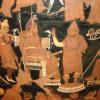The Alexander Mosaic.
Commentary
Collection: Museo Archaeologico Nazionale di Napoli
Accession Number: 10020
The Alexander Mosaic
Alexander (left) charges against Darius (right), whose chariot turns backwards as Alexander stabs a Persian with his spear. The battle is chaotic; it has been identified as either the Battle of Gaugamela or the Battle of the Issos. Any suggestion is problematic and the secondary literature has found any number of interesting solutions to the question, all of which merit a certain degree of scepticism; see, for instance, Moreno for Gaugamela (despite the section on the angle of the sun; P. Moreno, Apelles. The Alexander Mosaic (Milan, 2001), 15-18) and Stewart for the Issos (A. Stewart, Faces of Power (Berkeley, 1993), 134ff.). A date towards the end of the 2nd century BC for the mosaic is likely, largely based on the appearance of similar scenes on Italian artworks around this time, perhaps following the events in Macedon of 168 or 148 BC (A. Stewart, Faces of Power (Berkeley, 1993), 133).
This famous piece of historical artwork comes from the House of the Faun in Pompeii; more specifically it decorated the floor of the exedra connecting the villa’s two large peristyles. By virtue of its context, it offers a complex dual perspective on Darius (and on Alexander): that of the Italians who had the mosaic installed in the villa and that of its original Greco-Macedonian audience.
The mosaic was probably copied from a painted Greek original for a Roman/Italian patron (compare P. Moreno, Apelles. The Alexander Mosaic (Milan, 2001), 11-15, arguing that the mosaic was originally copied in (probably) Macedon, before being transferred to its Pompeian context). Pliny’s observation that Apelles only painted in white, yellow, red, and black (Pliny N.H.35.32; compare P. Moreno, Apelles. The Alexander Mosaic (Milan, 2001) 34ff.) suggests that there was a painted original behind the mosaic and has been used to propose Apelles as a candidate. The question of the artist behind the original is complex; it is, however, worth noting that comparison with the colouring and style of Macedonian funerary paintings – such as those found at Vergina – suggests that we ought not to imagine Apelles as the only candidate for the artist behind the mosaic. Indeed, Philoxenus of Eretria seems like another good candidate for the artist, given Pliny N.H.35.36.110 (see also A. Stewart, Faces of Power (Berkeley, 1993) 147ff. for a good argument in favour).
Arguably – if the mosaic in its Roman context was meant to be “interpreted” at all – the “meaning” of the mosaic as a Roman/Italian copy is likely to be highly complex. As Cohen has pointed out, we have to navigate not only Roman, but Samnite and romanised Samnite perspectives; see A. Cohen, The Alexander Mosaic: Stories of Victory and Defeat (Cambridge, 1997) 176-182 and 187-194 (this book is a particularly good introduction to the mosaic, especially because of the focus on its context within the villa and beyond). This presentation might also interact in some way with that of the Darius painter, also a product of Southern Italy. For further comparanda (there are several surviving examples from Italy of scenes in which Darius is pursued by Alexander), see P. Moreno, Apelles. The Alexander Mosaic (Milan, 2001) 83-96 (particularly 84-87 and 91ff.).
If we can consider the mosaic as a reflection of a Greek original, we might then consider whether it was a deliberately unheroic presentation of Alexander intended by Cassander to blacken the legacy of the great conqueror (as E. Badian, ‘A Note on the “Alexander Mosaic”’ in E. Badian Collected Papers on Alexander the Great (London, 2012), 404-420) or – conversely – an attempt by the latter to re-write history, forgetting their differences and replacing them with a clear demonstration of Cassander’s loyalty to the deceased Macedonian king (A. Stewart, Faces of Power (Berkeley, 1993) 147ff.). Such readings clearly have important implications for how the Achaemenid Darius and his men are understood.
Studies of this mosaic typically focus on Alexander; but what does it tell us about the reception of Darius – and Achaemenids more generally – by audiences in antiquity?

